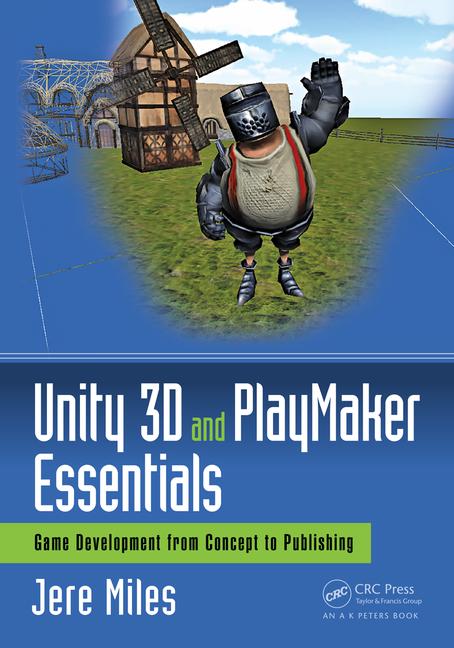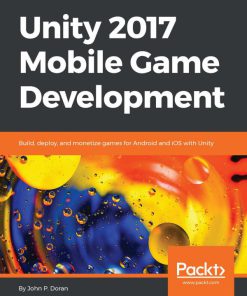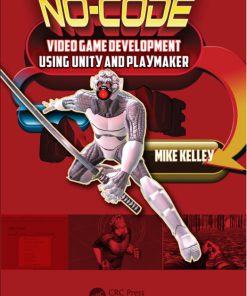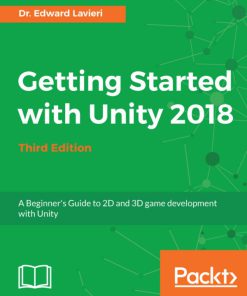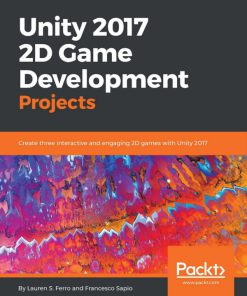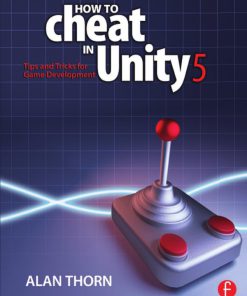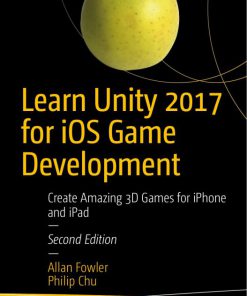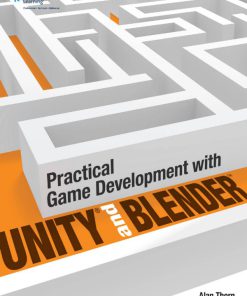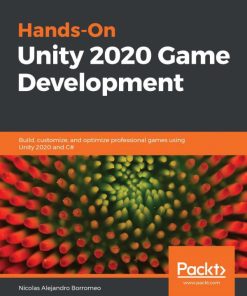(Ebook PDF) Unity 3D and PlayMaker Essentials 1st edition by Jere Miles 1317414314 9781317414315 full chapters
$50.00 Original price was: $50.00.$25.00Current price is: $25.00.
Authors:Jere Miles , Series:Gaming [122] , Author sort:Miles, Jere , Languages:Languages:eng , Publisher:CRC Press
Unity 3D and PlayMaker Essentials 1st edition by Jere Miles – Ebook PDF Instant Download/DeliveryISBN: 1317414314, 9781317414315
Full download Unity 3D and PlayMaker Essentials 1st edition after payment.
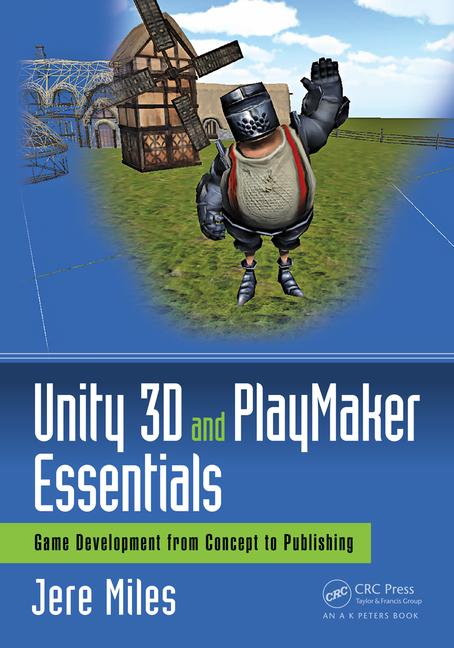
Product details:
ISBN-10 : 1317414314
ISBN-13 : 9781317414315
Author : Jere Miles
In introducing new students to video game development, there are two crucial components to consider: design and implementation. Unity 3D and PlayMaker Essentials: Game Development from Concept to Publishing provides theoretical background on topics such as characters, stories, level design, interface design, audio, game mechanics, and tools and skills needed. Each chapter focuses on a specific topic, with topics building upon each other so that by the end of the book you will have looked into all the subjects relevant to creating your own game. The book transitions from discussion to demonstrations of how to implement techniques and concepts into practice by using Unity3D and PlayMaker. Download boxes are included throughout the book where you can get the version of the game project under discussion or other content to add to the project, as well as any supplementary video tutorials that have been developed. Addressing both theoretical and practical aspects, Unity 3D and PlayMaker Essentials enables you to understand how to create a game by having you make a game. By gradually completing your own design document through the course of the book, you will become familiar with core design principles while learning the practical skills needed to bring your unique game to life.
Unity 3D and PlayMaker Essentials 1st Table of contents:
Section I Background
1 Introduction
1.1 Who Plays Games?
1.2 How Are Games Made?
1.2.1 AAA Studios
1.2.2 The Indie Studio
1.3 Who Can Make Games?
1.3.1 Skills and Jobs
1.3.2 Working in the Industry
1.4 What Types of Games Are There?
1.4.1 Role-Playing Games
1.4.2 Adventure Games
1.4.3 Platformer Games
1.4.4 Shooter Games
1.4.5 Action Games
1.4.6 Strategy Games
1.4.7 Simulation Games
1.4.8 Sports Games
1.4.9 Puzzle Games
1.4.10 MMO Games
1.5 Summary
Vocabulary
Review Quiz
Exercises
Design Document
2 Design Document
2.1 Introduction to the Design Document
2.1.1 Do We Need a Design Document?
2.1.2 Methods of Design
2.1.3 Logical Design versus Descriptive Design
2.1.4 Mission and Vision
2.2 Sections of the Design Document
2.2.1 Game Concept
2.2.2 Game Characters
2.2.3 Game Story
2.2.4 The Game World
2.2.5 Game Audio
2.2.6 Game Interface
2.3 Summary
Vocabulary
Review Quiz
Exercises
Design Document
3 Using Unity and PlayMaker
3.1 Installing Unity
3.2 Unity’s Interface
3.3 Using Unity
3.4 Installing PlayMaker
3.5 PlayMaker’s Interface
3.6 State Machines
3.7 Using PlayMaker
3.8 Summary
Vocabulary
Review Quiz
Exercises
Design Document
Section II Building Blocks
4 Characters
4.1 The Purpose of Characters
4.2 Do Games Need Characters?
4.3 Traditional Character Types
4.3.1 The Hero
4.3.2 The Shadow
4.3.3 The Mentor
4.3.4 The Ally
4.3.5 The Herald
4.3.6 The Trickster
4.3.7 The Shapeshifter
4.3.8 The Threshold Guardian
4.4 Game Character Types
4.4.1 Merchants
4.4.2 The Quest Giver
4.4.3 Information
4.5 Character Design
4.6 Character Asset Design
4.7 Importing Assets in Unity
4.7.1 Back to Projects
4.7.2 Importing 3D Assets
4.7.3 Settings for Imported 3D Assets
4.7.4 From 3D Assets to Player Controllable Assets
4.8 Character Control Systems with PlayMaker
4.8.1 Designing the Character Response System
4.8.2 Getting Input through Unity
4.8.3 Building State Machines in PlayMaker
4.9 Summary
Vocabulary
Review Quiz
Exercises
Design Document
5 Non-Player Characters
5.1What Is Artificial Intelligence?
5.2 Some Different Types of Artificial Intelligence
5.2.1 Scripted Behavior
5.2.2 Random Behavior
5.2.3 Expert Systems
5.2.4 Mathematical Behavior Modeling
5.2.5 Evolutionary Systems
5.3 Selecting an Artificial Intelligence System
5.4 Designing a Threshold Guardian
5.5 Implementing the Threshold Guardian
5.5.1 The Controller
5.5.2 Patrolling
5.5.3 Spotting the Player
5.5.4 Attacking the Player
5.5.5 Hurting the Player
5.5.6 Connecting the Attack and Health States
5.5.7 Final Tweaks
5.6 Prefabs
5.7 Summary
Vocabulary
Review Quiz
Exercises
Design Document
6 Story
6.1 What Is a Story?
6.2 Does My Game Need a Story?
6.3 How to Tell a Story
6.4 The Building Blocks of a Story
6.4.1 Characters
6.4.2 Setting
6.4.3 The Problem
6.4.4 The Plot
6.4.5 The Solution
6.4.6 The Theme
6.5 Aristotle and the Greeks
6.5.1 Plot
6.5.2 Characters
6.5.3 Thought
6.5.4 Diction
6.5.5 Melody
6.5.6 The Spectacle
6.6 The Return of Joseph Campbell
6.6.1 The Ordinary World
6.6.2 Call to Adventure
6.6.3 Refusal of the Call
6.6.4 Meeting the Mentor
6.6.5 Crossing the Threshold
6.6.6 Tests, Allies, and Enemies
6.6.7 Approaching the Cave
6.6.8 The Ordeal
6.6.9 The Reward
6.6.10 The Road Back
6.6.11 Resurrection
6.6.12 Return with Elixir
6.7 Story Design
6.7.1 The Theme
6.7.2 Characters
6.7.3 Setting and Backstory
6.7.4 The Problem
6.7.5 The Plot
6.7.6 The Solution
6.7.7 Dialogue
6.8 Putting the Story into the Game
6.8.1 Voice-Over Narration
6.8.2 Written Text
6.8.3 Character Dialogue
6.8.4 Journal Systems
6.9 Summary
Vocabulary
Review Quiz
Exercises
Design Document
7 Environment
7.1 Environments for Stories
7.2 Environments for Games
7.2.1 Controlling the Player
7.2.2 Informing the Player
7.2.3 Challenging the Player
7.2.4 The Final Design
7.3 Creating the Terrian in Unity
7.3.1 Settings
7.3.2 Terrian Collider
7.3.3 Height Tools
7.4 Dressing a Terrian with Standard Content
7.4.1 Painting Textures
7.4.2 Adding Water
7.4.3 Adding Trees
7.4.4 Adding Grass
7.5 Adding Imported Assets
7.6 Lighting the Environment
7.7 Boundaries
7.8 Summary
Vocabulary
Review Quiz
Exercises
Design Document
8 Mechanics
8.1What Are Game Mechanics?
8.1.1 The Core Mechanics
8.1.2 Victory and Loss Conditions
8.1.3 Balance Mechanics
8.1.4 Story Mechanics
8.1.5 System Mechanics
8.2 Where Do Mechanics Come From?
8.3 Designing Our Mechanics
8.3.1 The Checkpoint System
8.3.2 Respawning Sancho
8.3.3 Sancho and Water
8.3.4 Sancho’s Collection System
8.4 Implementing Our Mechanics
8.4.1 The Checkpoint System
8.4.2 Sancho and Water
8.4.3 Respawning Sancho
8.4.4 Sancho’s Collection System
8.5 Summary
Vocabulary
Review Quiz
Exercises
Design Document
Section III Bringing It Together
9 Audio
9.1 How Audio Is Used in Games
9.1.1 Music
9.1.2 Ambience
9.1.3 Sound Events
9.2 Finding Audio
9.3 Introduction to Audacity
9.3.1 Cutting Up an Audio File
9.3.2 Applying Effects to Audio
9.3.3 Adjusting Volume Levels
9.4 Audio in Unity
9.4.1 2D Audio
9.4.2 3D Audio
9.4.3 Playing Ambient Audio
9.4.4 Playing Background Music
9.5 Using PlayMaker to Play Audio
9.5.1 Background Music
9.5.2 Ambient Sounds
9.5.3 Effects for Events
9.6 Summary
Vocabulary
Review Quiz
Exercises
Design Document
10 The User Interface
10.1 The Types of User Interfaces
10.1.1 Menu-Based Systems
10.1.2 Heads-Up Display Systems and Overlays
10.2 User Interface Design
10.2.1 HUD Design
10.2.2 Menu Design
10.2.3 Basics of Color Theory
10.3 The User Interface System of Unity
10.3.1 Building Blocks of uGUI
10.3.2 Constructing the Main Menu
10.3.3 Constructing the HUD Overlay
10.3.4 Polishing the Dialogue Work
10.4 Updating the User Interface with PlayMaker
10.4.1 Responses on the Main Menu
10.4.2 Updating the Overlay
10.4.3 Integrating the Dialogue System
10.5 Summary
Vocabulary
Review Quiz
Exercises
Design Document
11 Testing, Tweaking, and Publishing
11.1 What Is Testing?
11.1.1 Hunting Bugs
11.1.2 Play-Through Testing
11.1.3 Unit Testing
11.1.4 Break Testing
11.2 Fixing and Tweaking
11.2.1 Fixing the Following Sheep
11.3 Building the Game
11.3.1 Game Development Life Cycle
11.3.2 Build Options in Unity
11.3.3 Creating a Stand-Alone Build
11.4 Summary
People also search for Unity 3D and PlayMaker Essentials 1st:
unity3d playmaker
unity playmaker animation
unity playmaker easy save
unity playmaker review
unity playmaker ecosystem
You may also like…
eBook PDF
(EBook PDF) How to Cheat in Unity 5 1st edition by Alan Thorn 1317622715 9781317622710 full chapters

